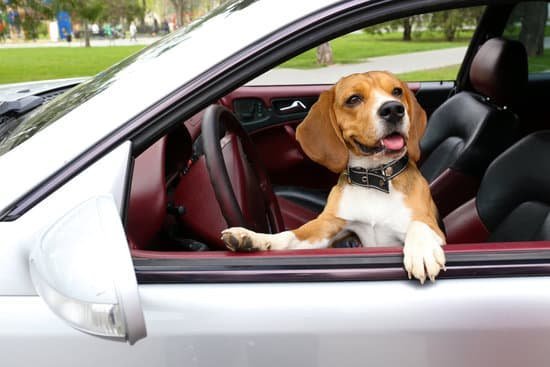Is your furry friend feeling anxious and jittery? In this article, we will explore the essential steps on how to train a very nervous dog. Understanding the root causes of your dog’s nervous behavior is crucial in addressing and managing their anxiety effectively.
There can be various reasons behind a dog’s nervousness, such as past trauma, lack of socialization, genetic predisposition, or even certain health issues. Recognizing the signs and symptoms of a nervous dog is the first step towards helping them overcome their fears and anxieties. By observing their body language, behavior changes, and triggers that lead to anxious episodes, you can tailor your training approach to suit their specific needs.
Creating a safe and calm environment for training is key to supporting a nervous dog. Establishing a consistent routine that includes regular exercise, mental stimulation, and plenty of positive reinforcement can help build trust and confidence in your furry companion. By providing predictability and structure in their daily lives, you can reduce their stress levels and create a nurturing space for them to learn and grow.
Signs and Symptoms of a Nervous Dog
A dog’s nervous behavior can manifest in various ways, and it is essential for pet owners to be able to recognize the signs and symptoms of anxiety in their furry companions. Common indications of a nervous dog include excessive panting, trembling, pacing, whining, barking, hiding, or showing signs of aggression such as growling or snapping. In some cases, a nervous dog may also exhibit destructive behaviors like chewing furniture or excessive licking.
Observing your dog’s body language is crucial in understanding their emotional state. Signs like pinned-back ears, a tucked tail, dilated pupils, or avoiding eye contact can all indicate anxiety or fear in dogs. It is important to pay attention to these cues as they can help you identify situations that trigger your dog’s nervousness and address them effectively.
Recognizing the signs and symptoms of a nervous dog is the first step towards helping them overcome their anxieties through proper training techniques. By understanding your dog’s specific triggers and reactions, you can tailor your training approach to suit their individual needs and provide them with the support and guidance they need to build confidence and trust.
In the following sections, we will explore how to create a safe environment for training and use positive reinforcement techniques to encourage good behavior in very nervous dogs.
Creating a Safe and Calm Environment for Training
Nervous dogs can often struggle with training due to their anxiety and fear. Creating a safe and calm environment for training is essential in helping your dog overcome their nervous behavior and build trust with you. One important aspect of creating this environment is to eliminate any potential triggers that may exacerbate your dog’s anxiety. This could include loud noises, unfamiliar people or animals, or any other stimuli that may cause distress.
It is also crucial to establish a consistent routine during training sessions. Dogs, especially nervous ones, thrive on predictability and structure. By maintaining a regular schedule for training sessions, your dog will become more comfortable and confident in their surroundings. Consistency in your approach to training will also help your dog understand what is expected of them, which can reduce their anxiety levels.
Another key element in creating a safe environment for training a very nervous dog is to maintain a calm demeanor yourself. Dogs are incredibly perceptive animals and can pick up on their owner’s emotions easily. If you stay calm and patient during training sessions, your dog will feel more at ease and be more receptive to learning. Remember that building trust takes time, so be compassionate and understanding as you work with your nervous dog.
| Key Points | Action Steps |
|---|---|
| Eliminate triggers | Avoid loud noises or unfamiliar stimuli during training |
| Establish consistency | Maintain a regular schedule for training sessions |
| Maintain a calm demeanorStay patient and compassionate during training sessions |
Establishing a Consistent Routine to Build Trust and Confidence
Creating a consistent routine is crucial when it comes to training a very nervous dog. Dogs thrive on consistency and predictability, so having a structured daily schedule can help build their trust and confidence. This routine should include regular feeding times, potty breaks, playtime, and training sessions. By providing your nervous dog with a sense of stability and routine, you are helping them feel more secure in their environment.
Incorporating regular training sessions into your dog’s daily routine can also help build trust and confidence. Start with short training sessions focused on basic commands like sit, stay, and come. Use positive reinforcement techniques such as treats, praise, and toys to reward good behavior. Consistency is key – practice these commands daily to help your nervous dog feel more confident in their abilities.
Another important aspect of establishing a consistent routine for a nervous dog is ensuring they get enough exercise. Physical activity not only helps release excess energy but also promotes mental stimulation which can reduce anxiety. Daily walks, interactive play sessions, or even obedience classes can all contribute to building your dog’s confidence and overall well-being.
| Behavior | Recommendation |
|---|---|
| Regular feeding times | Include in daily routine for stability |
| Short training sessions | Use positive reinforcement for confidence building |
| Physical activity | Ensure enough exercise for mental stimulation |
Using Positive Reinforcement Techniques to Encourage Good Behavior
What Is Positive Reinforcement?
Positive reinforcement involves rewarding your dog for exhibiting the desired behavior. This can be in the form of treats, praise, toys, or any other positive stimuli that motivates your furry friend. By using positive reinforcement, you are encouraging your nervous dog to repeat the behavior you want to see more of.
Implementing Positive Reinforcement With a Nervous Dog
When training a very nervous dog, it is essential to use positive reinforcement techniques gently and consistently. Start by identifying what motivates your dog the most – whether it’s a favorite treat or a special toy. Use these rewards to reinforce good behavior such as sitting calmly, walking without pulling on the leash, or interacting positively with other dogs or people.
Benefits of Positive Reinforcement for Nervous Dogs
Positive reinforcement not only helps in shaping good behavior but also boosts your dog’s confidence and trust in you as their owner. It creates a positive association between training sessions and rewards, making the learning process enjoyable for your nervous pet. Remember to be patient and consistent in your training approach, and soon enough, you will start seeing positive changes in your dog’s behavior.
Gradual Exposure to Triggers to Desensitize the Dog
Introduction to Desensitization Training
Desensitization training is a valuable tool when it comes to helping very nervous dogs overcome their fears and anxieties. This technique involves exposing the dog to the triggers that cause their nervous behavior in a gradual and controlled manner. The goal is to help the dog learn to be calm and relaxed in the presence of these stimuli, ultimately reducing their fear response.
Creating a Desensitization Plan
When embarking on desensitization training with a very nervous dog, it’s essential to create a detailed plan that outlines the specific triggers you will be working on, the intensity of exposure, and the steps for gradual progression. Start with identifying the least triggering situation and gradually increase the intensity as your dog becomes more comfortable. Remember, patience is key in this process as rushing could backfire and heighten your dog’s anxiety further.
Implementing Desensitization Techniques
During desensitization training sessions, it’s crucial to remain calm and patient with your nervous dog. Use positive reinforcement techniques such as treats, praise, or toys to reward calm behavior when exposed to triggers. Keep training sessions short and frequent to prevent overwhelming your furry companion.
Consistency is key in desensitization training – ensure that each session builds upon the progress made in previous ones. With time, dedication, and a lot of love, you can help your very nervous dog overcome their fears and lead a happier, more relaxed life.
Seeking Professional Help if Necessary
Seeking professional help for training a very nervous dog can be a crucial step in addressing challenging behavior and ensuring the well-being of your furry friend. Trained professionals, such as certified dog trainers or animal behaviorists, have the expertise and experience to work with fearful or anxious dogs effectively. They can provide guidance on how to train a very nervous dog in a way that is tailored to their specific needs and triggers.
A professional trainer or behaviorist can conduct a comprehensive assessment of your dog’s behavior and temperament to identify the underlying causes of their anxiety. By understanding the root causes of your dog’s nervous behavior, the trainer can develop a personalized training plan that addresses these issues in a positive and effective manner. This individualized approach is essential for helping your dog overcome their fears and build confidence.
In some cases, medication may be necessary to support training efforts for very nervous dogs. A qualified veterinarian can assess your dog’s condition and prescribe appropriate medications to help manage severe anxiety or phobias. It is important to consult with both a veterinarian and a professional trainer when considering medication for your pet, as this approach should be part of a comprehensive treatment plan that includes behavioral modification techniques.
Monitoring Progress and Celebrating Small Victories
Understanding the root causes of a dog’s nervous behavior is essential in effectively training a very nervous dog. Some common reasons for a dog to exhibit nervousness include past traumatic experiences, lack of socialization, genetic predisposition, or even a medical condition. By identifying the underlying cause of your dog’s nervous behavior, you can tailor your training approach to address their specific needs and provide the necessary support.
Signs and symptoms of a nervous dog can vary from excessive barking and trembling to destructive behavior and even aggression. It is crucial to pay attention to these cues and respond with patience and understanding. By recognizing when your dog is feeling anxious or overwhelmed, you can adjust your training strategies accordingly and create a safe space for them to learn and grow.
Creating a safe and calm environment for training is key when working with a very nervous dog. This can involve minimizing potential triggers, providing a quiet space for training sessions, and using tools such as calming pheromones or soothing music.
Additionally, establishing a consistent routine can help build trust and confidence in your dog, as they will come to understand what to expect during training sessions. By setting clear expectations and offering praise and rewards for good behavior, you can make the learning process more enjoyable for both you and your furry friend.
- Identify the root causes of your dog’s nervous behavior
- Pay attention to signs of anxiety in your pet
- Create a safe environment for training sessions
- Establish a consistent routine to build trust
- Use positive reinforcement techniques
- Gradually expose them to triggers
Building a Strong Bond With Your Nervous Dog Through Training Efforts
Training a very nervous dog can be a challenging but rewarding experience. By understanding the root causes of your dog’s anxiety, recognizing the signs and symptoms of nervous behavior, and creating a safe and calm environment, you can set the foundation for successful training. It is essential to establish a consistent routine to build trust and confidence in your furry companion.
Using positive reinforcement techniques can help encourage good behavior and strengthen the bond between you and your dog. Celebrating small victories along the way will not only boost your dog’s morale but also motivate you to continue with the training process. Gradual exposure to triggers that cause anxiety in your dog can help desensitize them over time, making them more comfortable in various situations.
If despite your best efforts, your dog’s nervous behavior persists or worsens, do not hesitate to seek professional help from a veterinarian or a certified dog trainer. They can provide specialized guidance and support tailored to your dog’s needs. Remember that patience, consistency, and love are key when it comes to training a very nervous dog. With dedication and perseverance, you can build a strong bond with your furry friend and help them overcome their fears.
Frequently Asked Questions
How Can I Stop My Dog Being So Nervous?
There are several ways to help your nervous dog feel more at ease. One effective method is to create a safe and secure environment for them, free from loud noises or triggers that may cause anxiety. Another approach is to establish a routine that provides structure and predictability, which can help reduce their stress levels.
How Do You Discipline a Nervous Dog?
When it comes to disciplining a nervous dog, it’s important to approach the situation with care and compassion. Punishment or harsh discipline can exacerbate their anxiety and fear, leading to further behavioral issues. Instead, focus on positive reinforcement techniques and reward good behavior to build their confidence and trust.
What Is the Way to Calm a Very Nervous Dog?
To calm a very nervous dog, it’s essential to remain calm yourself and provide reassurance through gentle petting or soothing words. Creating a quiet and relaxing environment can also help alleviate their anxiety. Additionally, consider incorporating activities like physical exercise or mental stimulation to redirect their focus and energy in a positive way.

Welcome to the blog! I am a professional dog trainer and have been working with dogs for many years. In this blog, I will be discussing various topics related to dog training, including tips, tricks, and advice. I hope you find this information helpful and informative. Thanks for reading!





